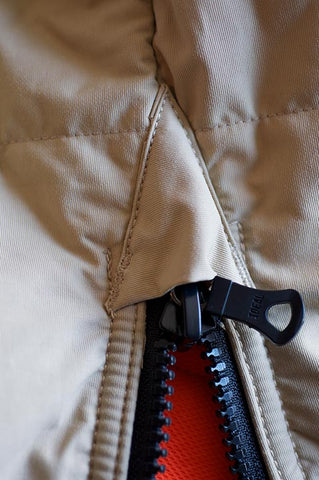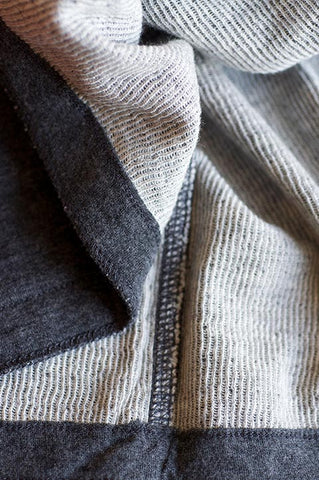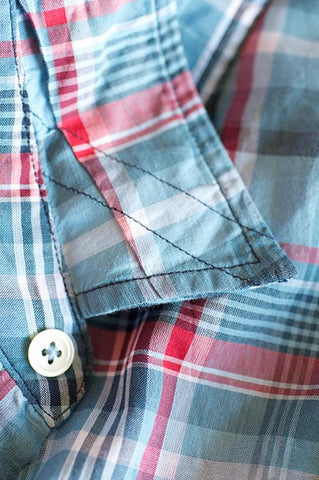|
|
 |
- Double stitched leather washers.
- Rockhard drawcords.
- 3-hole leather pignose stoppers.
|
|
 |
- Bound and reinforced seams throughout interiors for lasting durability and smooth finish.
|
|
 |
- Recessed holes built into buttons to reduce abrasion that weakens thread.
|
|
 |
- Fully bound interior zipper tape of our anorak, reflects the importance of minding details that no one ever notices—except when the item fails.
|
|
 |
- Gussets built into positions of stress for protective movement.
|
|
 |
- Working sleeve buttons on blazers, add utility, folding cuffs out of the work.
|
|
 |
- Soft lined pockets of fleece pile or brushed tricot, providing extra thickness and security.
|
|
 |
- Pocket welt openings with added reinforcement layers thru welt and triangular point.
- Heavy zig-zag bartacks at stress points.
|
|
 |
- Quilt-thru stitching from side to side to maintain insulation positions.
|
|
 |
- Functional throat tabs on blazers and jackets, because nature happens.
|
|
 |
- Hidden game pockets built into rear sideseams of every blazer, storage for the least expected moments.
|
|
 |
- Rib knit cuffs extending from liners of every style.
|
|
 |
- Dense cotton cording of our Military Parka, faithful to the smallest detail, adding 2x the durability with double cording.
|
|
 |
- Hidden woven tape reinforced snap positions, firmly securing fastener hardware.
|
|
 |
- Elbow pleats on jackets, centered over elbows, place fullness and ease at points of movement.
|
|
 |
- Sweater buttons firmly attached through reinforcement materials at backs of garments.
|
|
 |
- Ultrasuede reinforcements behind buttons of our Shawl neck sweater.
|
|
 |
- Jersey bound thumbholes on longer rib knit cuffs, just as easily rolled in half or used to grip forearms.
|
|
 |
- Trapunto stitched placket opening with bound woven facing at top side.
- Horizontal buttonholes of our popovers/mocks aim to reduce stress on buttonholes and pay respect to construction methods of the past.
|
|
 |
- Woven shoulder tape across back neck and shoulder seams provides a clean finish look, helping maintain the shape of the garment when worn.
- Raw seams also covered with such tape, reducing thread and seam breakage in these areas of stress.
|
|
 |
- Raw open knit hems with jersey facings directly applied without folded seam allowance to allow for a flatter and more seamless look at waist.
|
|
 |
- Split tail hem with woven reinforcement and bartack to insure lasting function.
|
|
 |
- Double layer fabric in our flannel shirts with 8-ply felled seams.
- Attentively matched patterns at front and back panels.
|
|
 |
- 1/4" single needle construction of our lightest weight shirtings
- All patterns matching at sideseams, center front, and pocketing.
- Triangular self-fabric reinforcement at split tail limits garment from breakage at this position.
|
|
 |
- Subtly curved top collar to properly sit around neck.
- Shell buttons anchored at corners along with reinforcing 2nd ply of material at interior of shirt.
|
|
 |
- Straight collar shirtings with open slots at backside for collar stays.
- Never do we recommend collar stays, but the added fabric layers (from folding the materials to create the slots) provides desirable thickness and body for the collar points.
|
|
 |
- Beltloops of 4 ply thickness with 1/16" rolled lip.
- All beltloops inserted at top of waistbands between waistband facing and exterior shell.
|
|
 |
- Opening hems of bottoms with separate fabric facing, provides a flatter finish with added weight, as well as making it easier to hold a rolled cuff.
|
|
 |
- Patch pockets cut with +1/2" fullness across width to allow contents to push outward away from body and not inward against the fit of the garment.
|
|
 |
- Woven tape reinforcements extending from behind beltloops at interior of bottoms to increase the strength of the garment.
|
|
 |
- Folded seams of a pant (or any garment) helps convey quality workmanship.
- Here a 2nd layer of facing sits behind the pocket opening and is rolled 1/8" away from the opening edge to prevent visibility at topside.
|
|


































